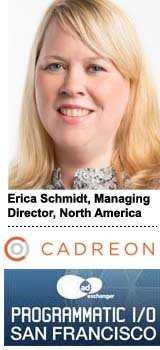Erica Schmidt, managing director of North America for Cadreon, will speak about the state of programmatic and advanced TV at Programmatic IO on April 5 in San Francisco.
The times, they are a-changing for traditional TV planners.
Advertisers and agencies increasingly expect to buy TV, over-the-top (OTT) and mobile on a converged basis. And many want to bring their own data to the bargaining table.
For example, Interpublic Group’s investment arm, Magna, revealed in January it would double its spend on Roku. In addition, it would create custom targeting segments via IPG’s ad tech unit, Cadreon.
As viewership shifts to OTT and short-form video, agencies have been forced to adapt their planning strategies.
“The bulk of where time and dollars are spent is not on traditional TV anymore and we, as an industry, are just trying to catch up with that,” said Erica Schmidt, the North American managing director for Cadreon.
Schmidt spoke with AdExchanger about the changing inventory and planning environment for TV buyers.
AdExchanger: How does an investment deal between Magna and Roku impact Cadreon?
ERICA SCHMIDT: TV planning used to be very channel-specific, but that’s not the way audiences are consuming content. The Roku deal was very similar to our approach when we do private marketplaces to make sure we have the right access point to that inventory and that the rates we pass through to clients are advantageous to them.
We have to do a bit of alignment around packaging this consistently so we’re fulfilling on the value proposition of the partnership, but the relationship between Cadreon and Magna allows us to bring things together in a really meaningful way.
IPG’s advanced TV planners used to sit under Magna, but now they’re housed within Cadreon. Can you update us on that progression?
At the beginning of last year, we had an advanced TV team underpinned by Cadreon infrastructure and leadership, but it wasn’t formally under the Cadreon branding. We united the advanced TV team [previously under Magna branding] with our programmatic digital teams at Cadreon. Year one was making sure we had the packaging right. That our value proposition was right. We made progress, but not nearly the progress I would have liked to see.
What do you mean?
TV planners working on our advanced TV practice have TV fluency. Most of my team on the programmatic digital side are digital natives or came to us at an entry position and have grown in their role and don’t necessarily understand TV.
My goal this year is to get these teams cross-fluent and get cross-screen planning and buying off the ground. We work in an ecosystem with media agencies that have tried, true, measured and still very relevant practices around channel planning and allocation, but today’s audiences don’t think about channel. We have a big opportunity to bring that together this year.
What’s one of the difficulties TV planners face as viewership moves to OTT?
A lot of OTT inventory is tied up with upfront commitments and the networks to fulfill on the ratings what they’re guaranteeing. The only way they can do that is by leveraging other assets that are nonlinear.
The other piece of it is the technology. Three or four years ago, video was the Wild West. Now OTT is the Wild West. There are different formats and means of activation, and you have to cobble through the inventory sources. And there’s still walled gardens.
With more telcos snapping up digital media and ad tech, will it improve or complicate things?
Everyone’s getting more serious about identity and [deterministic] data and it’s really exciting, but it’s also going to become more cumbersome to navigate that attribution equation.
What’s your top measurement prediction?
Measurability of traditional media is not perfect, but with data and technology, it’s a hell of a lot better than it used to be. It’s about applying those elements of accountability to the TV ecosystem. You could argue people did this with DRTV, but that was always a very specific activation, budget and client.
We need to collectively acknowledge that measurement is not exactly where it needs to be. But, just as in the early days of digital, the demand for measurability and the expectation for measurability were probably higher than the actual feasibility of doing it right now.
Interview has been condensed and edited.













